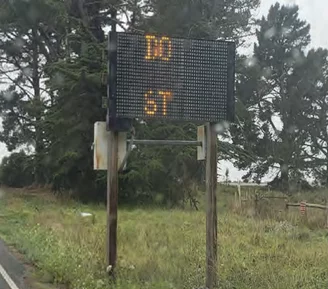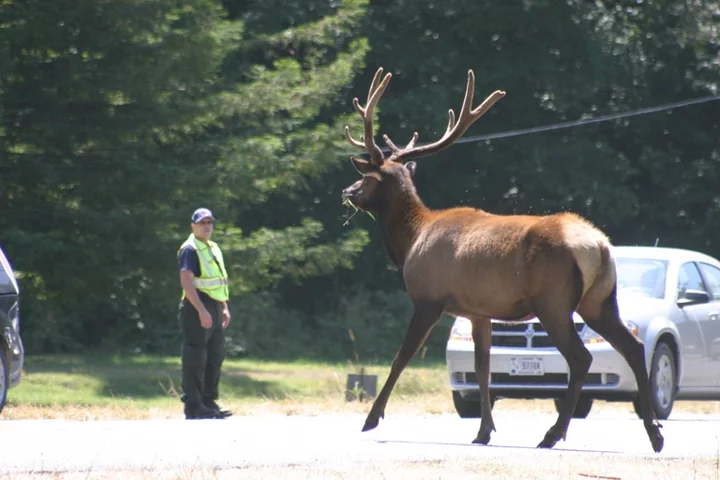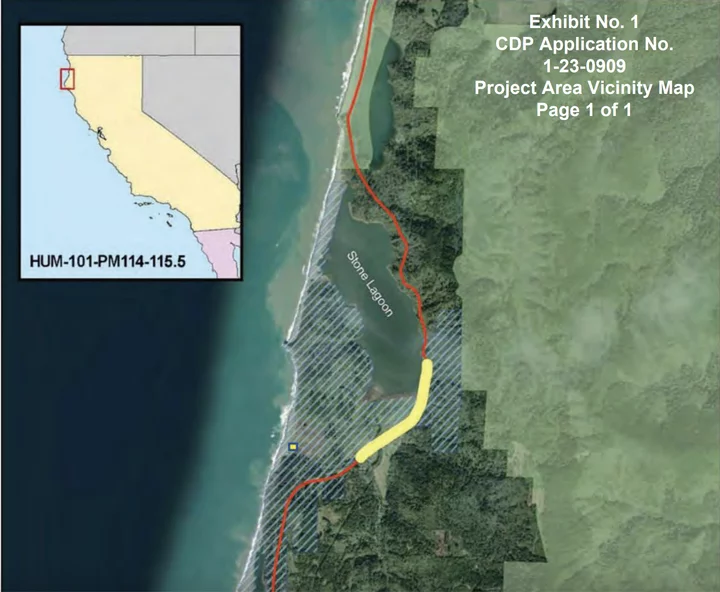Don’t forget to look both ways, buddy! | Photo via Cal Poly Humboldt.
###
The North Coast’s photogenic population of Roosevelt elk will soon get a little help crossing the road thanks to a high-tech detection-and-warning system along Hwy. 101 near Stone Lagoon.
The project, which was granted a permit waiver on Thursday by the California Coastal Commission, will create a network of approximately 25 very-high-frequency (VHF) transceivers on wooden poles along the highway.
Those devices will be triggered in real time by any tracking-collar-wearing elk who wander within 150 feet of the them. (The California Department of Fish and Wildlife has spent years capturing and GPS-collaring the massive Cervus canadensis roosevelti here on the North Coast for research purposes.)

For technical reasons, these Changeable Message Signs (CMS) really don’t photograph well. | Photo via the Coastal Commission.
When an elk enters the range of the sensors, it will set off a series of flashing LED warning lights and a pair of those changeable message signs (right) along the freeway, alerting drivers that elk may be on or near the roadway.
“These signs will be installed at both ends of a one-mile stretch of highway with the Stone Lagoon Red Schoolhouse at its center,” Caltrans Public Information Officer Myles Cochrane told the Outpost via email.
Caltrans also plans to install up to three new vehicle speed recorders along that stretch of road.
Adult Roosevelt bulls can weigh more than 1,000 pounds, and the local herd that lives near Stone Lagoon frequently crosses the freeway, which has led to collisions with vehicles, causing injuries and elk deaths. This area of highway has the highest concentration of elk crossings in coastal Humboldt and Del Norte counties, and it was ranked as the highest priority in Caltrans’ District 1 area for addressing roadkill in a large mammal-vehicle collision study.
The California Department of Transportation (Caltrans) developed this project following a collaborative study with CDFW and Cal Poly Humboldt.
It’s the first project of its kind in California, according to Caltrans. Data collected prior to and after installation — measuring efficacy, reliability and reproducibility — will be analyzed by Cal Poly Humboldt to determine whether similar systems should be installed elsewhere in the state to help decrease wildlife-vehicle collisions.
The project is near the Yurok Tribe-operated Chah-pekw O’ Ket’-toh “Stone Lagoon” Visitor Center, the first tribally operated visitor center in the California State Park system. According to a Coastal Commission staff report, Caltrans has been in close consultation with the tribe on the project. “The proposed improvements have been sited and designed such that the project will not impact tribal cultural resources,” the report says.
Caltrans hopes to have the system up and running by next year.
“We anticipate advertising for project contractors by February or March 2025, with construction slated for April or May 2025,” Cochrane said. “Our goal is to have the full system operational by next summer.”
Construction should take about two weeks, and during that time the Dry Lagoon public parking area may be unavailable.
“It’s important to note this is a research project,” Cochrane said. “Based on its success, Caltrans may keep the detection system in place or take other measures to reduce wildlife collisions.”


CLICK TO MANAGE